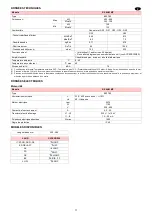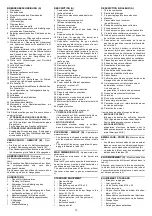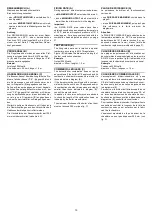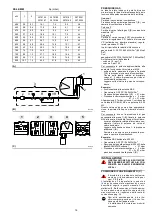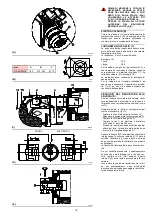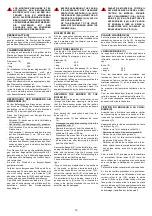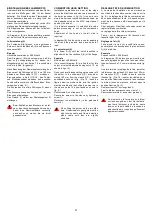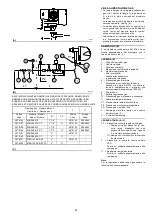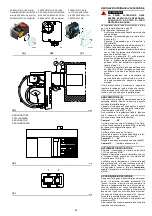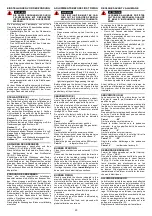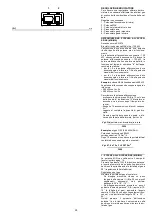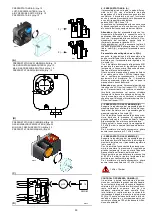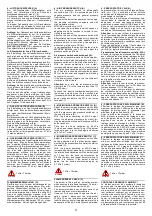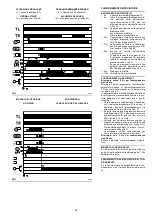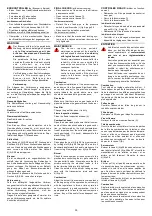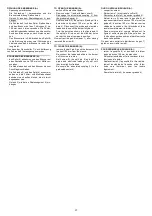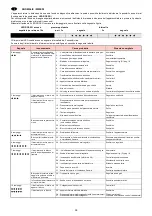
23
GASZULEITUNG
• Gasarmaturen sind über Flansch 2), Dichtung
3) und Schrauben 4), zur Brennerausstattung
gehörend, mit dem Gasanschluß 1)(A) zu ver-
binden.
• Die Armatur kann je nach Bedarf von rechts
bzw. links zugeführt werden, s. Abb. (A).
• Die Gasmagnetventile sollen so nah wie mög-
lich am Brenner liegen, damit die Gaszufuhr
zum Flammkopf innerhalb von 3 Sekunden
sichergestellt ist.
• Überprüfen, ob der Einstellbereich des Druck-
reglers (Farbe der Feder) die für den Brenner
erforderlichen Druckwerte vorsieht.
GASARMATUREN (B)
Nach Norm EN 676 typgeprüft, wird gesondert
mit dem in Tab. (C) angegebenen Code gelie-
fert.
ZEICHENERKLÄRUNG (B)
1 - Gaszuleitung
2 - Handbetätigtes Ventil
3 - Kompensator
4 - Manometer mit Druckknopfhahn
5 - Multibloc “mit Gewinde” umfasst:
- Filter (auswechselbar)
- Betriebsventil
- Druckregler
6 - Gas-Minimaldruckwächter
7 - Dichtheitskontrolleinrichtung der Gasven-
tile. Laut Norm EN 676 ist die Dichtheits-
kontrolle für Brenner mit Höchstleistung
über 1200 kW Pflicht.
8 - Dichtung
9 - Gas-Einstelldrossel
10 - Gas-Höchstdruckwächter (Zubehör)
11 - Passtück Armatur-Brenner
P1 - Druck am Flammkopf
P2 - Druck vor Ventilen/ Regler
P3 - Druck vor dem Filter
L - Gasarmatur gesondert mit dem in Tab. (C)
angegebenen Code geliefert
L1 - Vom Installateur auszuführen
ZEICHENERKLÄRUNG TABELLE (C)
C.T.= Dichtheitskontrolleinrichtung der Gasven-
tile:
- = Gasarmatur ohne Dichtheitskontrol-
leinrichtung; die Einrichtung kann
gesondert bestellt, siehe Spalte 7,
und später eingebaut werden.
♦
= Gasarmatur mit eingebaute
Dichtheitskontrolleinrichtung.
7
= Dichtheitskontrolleinrichtung
VPS
der
Gasventile.
Auf Anfrage gesondert von der Gasarma-
tur lieferbar.
11 = Passtück Armatur-Brenner.
Auf Anfrage gesondert von der Gasarma-
tur lieferbar.
Merke
Zur Einstellung der Gasarmaturen siehe die bei-
gelegten Anleitungen.
GAS LINE
• The gas train must be connected to the gas
attachment 1)(A), using flange 2), gasket 3)
and screws 4) supplied with the burner.
• The gas train can enter the burner from the
right or left side, depending on which is the
most convenient, see fig. (A).
• Gas solenoids must be as close as possible to
the burner to ensure gas reaches the combus-
tion head within the safety time range of 3s.
• Make sure that the pressure governor calibra-
tion range (colour of the spring) comprises the
pressure required by the burner.
GAS TRAIN (B)
It is type-approved according to EN 676 Stan-
dards and is supplied separately from the burner
with the code indicated in table (C).
KEY (B)
1 - Gas input pipe
2 - Manual valve
3 - Vibration damping joint
4 - Pressure gauge with pushbutton cock
5 - Multibloc, including:
- filter (replaceable)
- working valve
- pressure adjuster
6 - Minimum gas pressure switch
7 - Valve seal checking device.
In accordance with the standard EN 676,
gas valve leak detection control devices
are compulsory for burners with maximum
outputs of more than 1200 kW.
8 - Gasket
9 - Gas adjustment butterfly valve
10 - Max gas pressure switch (accessory)
11 - Gas train/burner adaptor
P1 - Pressure at combustion head
P2 - Up-line pressure of valves/adjuster
P3 - Pressure up-line from the filter
L - Gas train supplied separately with the code
indicated in table (C)
L1 - The responsibility of the installer
KEY TO TABLE (C)
C.T.= Gas
valves
leak
detection
control
devices:
- = Gas train without gas valve leak
detection control device; device that
can be ordered separately and
assembled subsequently (see Col-
umn 7).
♦
= Gas train with assembled VPS valve
leak detection control device.
7
= VPS valve leak detection control device.
Supplied separately from gas train on
request.
11 = Gas train/burner adaptor.
Supplied separately from gas train on
request.
Note
See the accompanying instructions for the
adjustment of the gas train.
LIGNE ALIMENTATION GAZ
• La rampe du gaz doit être reliée au raccord
correspondant 1)(A), par la bride 2), le joint 3)
et les vis 4) fournis de série avec le brûleur.
• La rampe peut arriver par la droite ou par la
gauche selon les cas, comme indiqué sur la
fig. (A).
• Les électrovannes du gaz doivent être le plus
près possible du brûleur de façon à assurer
l'arrivée du gaz à la tête de combustion en un
temps de sécurité de 3s.
• Contrôler si la plage de réglage du régulateur
de pression (couleur du ressort) recouvre la
pression nécessaire au brûleur.
RAMPE GAZ (B)
Elle est homologuée selon la norme EN 676 et
est fournie à part avec le code indiqué dans le
tableau (C).
LEGENDA (B)
1 - Canalisation d'arrivée du gaz
2 - Vanne manuelle
3 - Joint anti-vibrations
4 - Manomètre avec robinet à bouton poussoir
5 - Multibloc “filetté” comprenant:
- filtre (remplaçable)
- vanne de fonctionnement
- régulateur de pression
6 - Pressostat gaz de seuil minimum
7 - Dispositif de contrôle d'étanchéité vannes.
Selon la norme EN 676, le contrôle d'étan-
chéité est obligatoire pour les brûleurs
ayant une puissance maximale supérieure
à 1200 kW.
8 - Joint
9 - Papillon réglage gaz
10 - Pressostat gaz seuil maximum (acces-
soire)
11 - Adaptateur rampe-brûleur
P1 - Pression à la tête de combustion
P2 - Pression en amont vannes/régulateur
P3 - Pression en amont du filtre
L - La rampe gaz est fournie à part avec le
code indiqué dans le tab. (C)
L1 - A la charge de l'installateur
LEGENDE TABLEAU (C)
C.T.= Dispositif
de
contrôle
d'étanchéité
vannes:
- = Rampe sans dispositif de contrôle
d'étanchéité; dispositif qui peut être
commandé à part et monté par la
suite, voir colonne 7.
♦
= Rampe avec dispositif de contrôle
d'étanchéité VPS monté.
7
= Dispositif VPS de contrôle d'étanchéité
de la vanne.
Fourni sur demande séparément de la
rampe gaz.
11 = Adaptateur rampe-brûleur.
Fourni sur demande séparément de la
rampe gaz.
Note
Voir les instructions qui accompagnent la
rampe gaz pour la régler.



